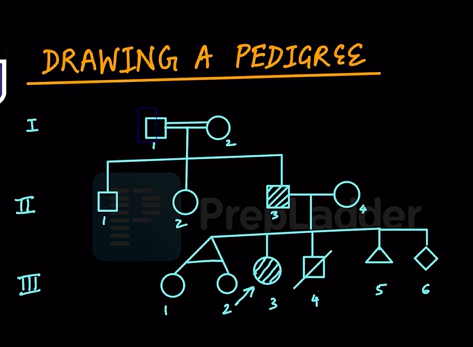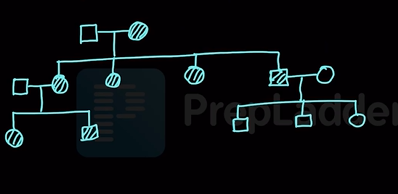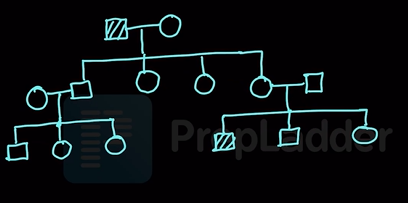Genetic Disorders : Causes, Classification : NEET PG Pathology
May 24, 2023
Navigate Quickly
What are Chromosomal Disorders?
Single Gene Disorders/Mendelian Disorders
Non-Mendelian disorders
Multifactorial Disorders
What are the Mendelian Disorders?
Autosomal Dominant Disorders
What are Autosomal recessive disorders?
What are X-linked Recessive Disorders?
When can Females Manifest X-linked Recessive Disorders?
What are the X-linked dominant disorder?
Pedigree
Mode of Inheritance
Mode of Inheritance
Non-Mendelian Disorders
Trinucleotide repeat disorder
Fragile X Syndrome
Mitochondrial disorders
What is Genomic Imprinting?
What is Gonadal mosaicism?

Chromosomal disorders are Disorders where the entire chromosome is affected either chromosome number or structure. Single gene disorders/Mendelian disorders follows Mendelian pattern of inheritance whereas Multifactorial inheritance are disorders where apart from genetic factors, environmental factors also play a very important role. Non-Mendelian disorders are disorders that do not follow typical Mendelian pattern of inheritance for example Trinucleotide repeat disorders, Gonadal imprinting .
Read this blog on important topics for pathology and get a taste of the best NEET PG coaching available online.

What are Chromosomal Disorders?
Disorders where either the structure or the number of chromosomes is affected. Chromosomes are large chunk of genetic materials (Total no of chromosomes in human – 46). Chromosome can either be missing, duplicated, or altered in some form. E.g., Down syndrome: Trisomy 21 (3 copies of Chr. 21 instead of 2) and Turner syndrome: 45, XO (Female with single X chromosome)
Non-Mendelian disorders
- Trinucleotide repeat disorders
- Mitochondrial disorders/Mitochondrial pattern of inheritance
- Genomic imprinting
- Gonadal mosaicism
Multifactorial Disorders
Disorders where apart from genetic factors, host related factors and environmental factors also plays a very important role. E.g., Cleft lip, cleft palate, Neural tube defects, Diabetes, Hypertension.
What are the Mendelian Disorders?
Single gene disorders which follow typical Mendelian pattern of inheritance :
Autosomal Dominant Disorders
Autosomal dominant disorders are those disorders that manifest even if one of the alleles of a gene is affected (both the alleles need not to be affected). In dominant disorders either of the parents is also affected by the same disorder (at least 1 parent is affected). Examples of autosomal dominant disorders :
- Hereditary spherocytosis, Hypercholesterolemia
- Ehlers Danlos syndrome
- Achondroplasia
- Von Willebrand disease
- Pseudohypoparathyroidism
- Dystrophia Myotonica (Myotonic dystrophies)
- Osteogenesis imperfecta (most types are autosomal dominant)
- Marfan syndrome -Clinical presentation of marfan syndrome is tall stature, arm span increased, arachnodactyly
- Intermittent porphyria
- Noonan syndrome
- Adenomatous polyposis coli (pre-cancerous condition for carcinoma colon)
- Neurocutaneous conditions – Neurofibromatosis and Tuberous sclerosis (runs in families)
What are Autosomal recessive disorders?
Disorders that manifest only if both the copies/alleles of a gene are affected If both the parents are carrier than only the children will manifest this disease. Wilson disease is caused by ATP 7B gene that is going to manifest only if both the copies/alleles of this gene are abnormal. In this the Parents are usually the carrier. If one of the parents is affected then all the babies will be carriers of that disorder even if the other parent is normal. Examples of autosomal recessive disorder:
- Albinism, Alkaptonuria
- β-Thalassemia - If both the parents have thalassemia trait then each baby have 25% risk of being affected
- Cystic fibrosis, Congenital adrenal hyperplasia
- Deafness (Congenital Sensorineural deafness)
- Emphysema caused by α1 antitrypsin deficiency
- Gaucher disease, Galactosemia
- Homocystinuria (classical variety)
- Mucopolysaccharidosis – Autosomal recessive inheritance
- Most of the metabolic disorders have autosomal recessive inheritance
What are X-linked Recessive Disorders?
These are sex chromosome (X) linked recessive disorders. Predisposition: Males are more commonly affected
Males Females
46, XY 46, XX
Since males have single X chromosome, and if that chromosome is abnormal then also disease is going to manifest as there is no other normal copy of X chromosome. Female have 2 X chromosomes, even if 1 X chromosome is affected, there is another normal copy of same gene on another X chromosome. Females are usually not affected in X-linked recessive disorder. All daughters of an affected male are going to be carriers. Father to son transmission is not seen as son receives Y chromosome from father and X chromosome from mother. Father to son transmission rules out X-linked inheritance
Examples of X-linked recessive disorders:
- G6PD (Glucose-6-Phosphate Dehydrogenase) deficiency : in this RBCs can get hemolyzed very easily so in this condition we should Avoid notorious drugs which precipitates hemolysis
- Duchenne muscular dystrophy (DMD)
- Color blindness- it is more common in males
- Fabry disease (Lysosomal storage disorder)
- Chronic granulomatous disease (CGD - Immunodeficiency condition)
- Hemophilia A and B
- Hunter disease (Type 2 MPS)
- Agammaglobulinemia/Bruton’s disease
- Albinism
- Lesch Nyhan syndrome- It is Self-mutilation disease in which there is uric acid accumulates in body
- History: If Child is affected and there is history that mother’s brothers is also affected with same disorder
When can Females Manifest X-linked Recessive Disorders?
In Female there are 2 X chromosomes, even if 1 X chromosome is affected, there is another normal copy of same gene on another X chromosome. If Female manifest X-linked recessive disorder if they have single X chromosome i.e., 45, XO then it can point towards Turner syndrome which is 45, XO. Normally, in females one of the X chromosomes get randomly inactivated and other remains active So, if X chromosome carrying abnormal allele remains active and normal one gets inactivated then the female can manifest the disease.
What are the X-linked dominant disorder?
It is More commonly seen in females. Female karyotype is 46, XX. This disease manifest only if one of the alleles is abnormal/affected. So, if one X chromosome is affected and other X chromosome is normal – Disease is still going to manifest. Male karyotype is 46,XY, If the only X chromosome in males is affected then this condition becomes lethal and they succumb in utero. All daughters of an affected male have the disease but all sons are normal Father to son transmission is not seen. Father to son transmission in pedigree rules out X-linked inheritanc.e
Examples of X-linked dominant disorders:
- Charcot Marie tooth disease – Peripheral neuropathy, Pes Cavus
- Alport syndrome (controversial)
- Rett syndrome
- Rickets: X-linked Hypophosphatemic rickets
Pedigree
Diagrammatic representation that shows the inheritance of various genetic trait through different generations in a family
Drawing of a Pedigree



Mode of Inheritance

For 1st generation: female is affected, all her children are affected. For 2nd generation -Male is affected but his children are not affected but Female is affected and all her children are affected. So its Interpretation is Mitochondrial inheritance
Mode of Inheritance

Male is affected but parents are unaffected that is Recessive pedigree Father’s father is affected. There is no father to son transmission so Interpretation is X-linked recessive inheritance.X-linked recessive inheritance runs more commonly in males e.g., Hemophilia, Duchene muscular dystrophy
Non-Mendelian Disorders
Trinucleotide repeat disorder
These disorders are due to increase in the number of trinucleotides repeats above a certain threshold . More the number of repeats, more the severity of disease .
“Anticipation” phenomenon: In this the disease manifestations worsen or appear at an earlier age in subsequent generations. It occurs because of increase in nucleotide number with each generation.
Examples
| Name of disorder | Repeats |
| Huntington disease | CAG |
| Myotonic dystrophy | CTG |
| Fragile X syndrome | CGG |
Fragile X Syndrome
Gene involved in fragile x syndrome is FMR-1ntal retardation) gene which is present on X chromosome :
| Genetic basis | No. of CGG repeats |
| Normal population | 5-55 |
| Carriers | 55-200 (premutation) |
| Fragile X syndrome | >200 repeats |
In premutation stage there are no clinical features seen . In females, it is associated with premature ovarian failure 10% of female may have intellectual disability/low IQ. It is more common in males.
- Clinical features
- Long face
- Large ears
- Large mandible/Prominent jaw
- High arched palate
- Hyperextensible joints
- Mitral valve prolapse
- Macroorchidism/large testes: Seen in adolescent age group
- Intellectual disability (developmental delay, mental retardation)
Also Read: Acute inflammation: Symptoms, Causes, and Treatment
Mitochondrial disorders
All children of an affected female have the disease . In all cells of body, there is nucleus containing nuclear DNA and mitochondria containing mitochondrial DNA present in cytoplasm.
When sperm penetrates ovum, only head of sperm enters the ovum. Head of sperm contains DNA material from father, Rest entire part of cell is formed from mother.When zygote forms entire ovum goes from mother and only head of sperm comes from father i.e., all mitochondrial DNA material/nuclear material comes from mother in the baby.
Heteroplasmy: Presence of both wild type (Normal) and mutated mitochondrial DNA in same individual
Threshold effect: The minimum percentage of mitochondrial DNA required for the manifestation of disease
Examples:
- Kearns Sayre syndrome
- Leber’s hereditary optic neuropathy
- MELAS (Mitochondrial Encephalo-myopathy, Lactic acidosis, Stroke like episodes)
- MERRF (Myoclonic epilepsy, Ragged red fibre)
- NARP (Neuropathy, Ataxia, Retinitis pigmentosa)
- CPEO (Chronic progressive external ophthalmoplegia)
- Pearson syndrome: Bone marrow involvement, pancytopenia, pancreatic involvement
What is Genomic Imprinting?
It is due to parent specific inactivation of certain genes. Genomic imprinting refers to alteration in DNA without any change in nucleotide sequence. It occurs due to epigenetic phenomenon. Epigenetic changes are Alteration in DNA without any change in nucleotide sequence. There is differential gene expression depending on the parent of origin Epigenetic change usually responsible is methylation of DNA.
Prader Willi syndrome – It is due to paternal gene silencing or imprinting
Angelman syndrome – It is due to maternal copy of the gene silencing or imprinting
Examples
|
Prader Willi syndrome |
Angelman syndrome |
|
|
|
|
|
|
What is Gonadal mosaicism?
It is a condition that occurs due to mutation that happens after zygote formation somatic cells are unaffected but gonadal cells/germ cells are affected. If Somatic cells are unaffected so Individual remains asymptomatic whereas gonadal cells affected so multiple children can be affected.
To scale up your NEET PG preparation with the best-in-class video lectures, QBank 6.0, Mock Tests and more, download the PrepLadder App!
Download PrepLadder's NEET PG preparation app for Android
Download PrepLadder's NEET PG preparation app for iOS

PrepLadder Medical
Get access to all the essential resources required to ace your medical exam Preparation. Stay updated with the latest news and developments in the medical exam, improve your Medical Exam preparation, and turn your dreams into a reality!
Top searching words
The most popular search terms used by aspirants
- NEET PG Pathology
- NEET PG Strategy
PrepLadder Version X for NEET PG
Avail 24-Hr Free Trial
